Menus
- Close to the beginning
- Clean throttle response, reliable rev up
- Harley usually lagged a little behind
- Downhill with 100 things – no problem
- European companies in the fast lane
- Tips for oldie fans
- Technical data Indian Twin Model F
- Technical data Harley-Davidson Model 11F
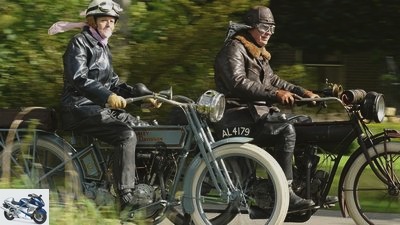
Fred Siemer
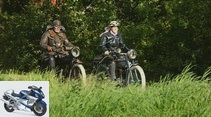
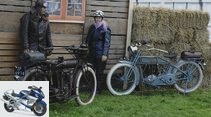
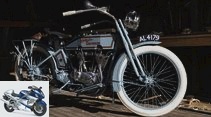
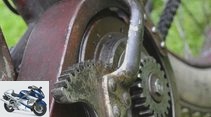
25th photos
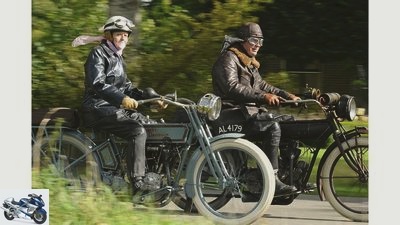
Fred Siemer
1/25
Harley-Davidson Model 11F and Indian Twin Model F.
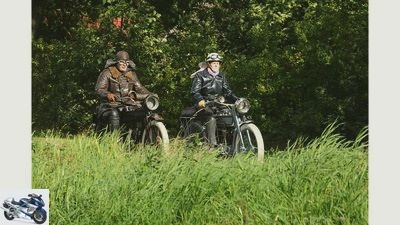
Fred Siemer
2/25
The Harley has been beautifully restored and the Indian is in striking original condition.
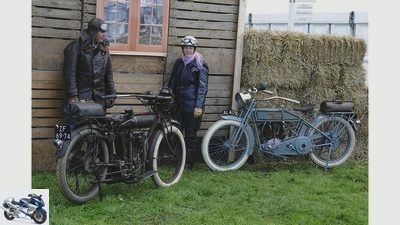
Fred Siemer
3/25
With his passion for old mechanics, Gert hit the ground running straight away in the Golden Twenties.
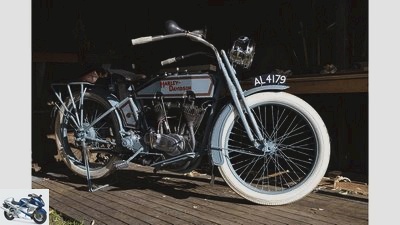
Fred Siemer
4/25
This Harley has been in Europe for a long time…
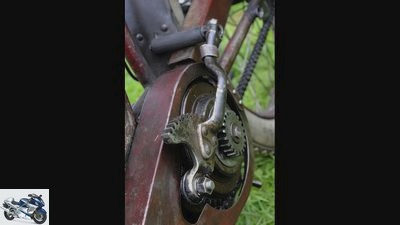
Fred Siemer
5/25
Indian Twin Model F..
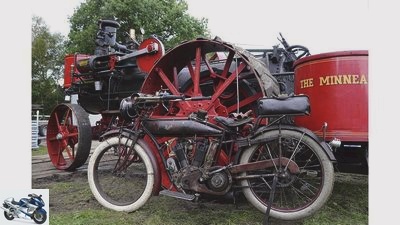
Fred Siemer
6/25
100 years ago Indian from Springfield / USA was considered the world’s largest motorcycle manufacturer.

Fred Siemer
7/25
Harley-Davidson Model 11F and Indian Twin Model F.
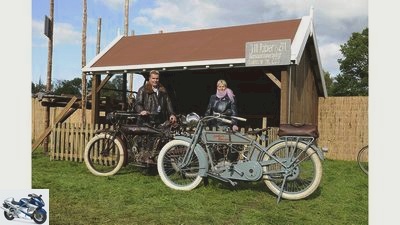
Fred Siemer
8/25
Harley-Davidson Model 11F and Indian Twin Model F.
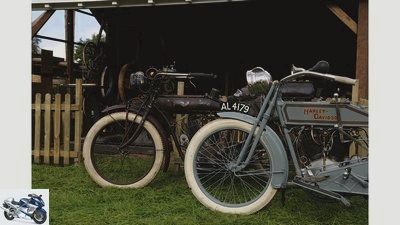
Fred Siemer
9/25
Harley-Davidson Model 11F and Indian Twin Model F.
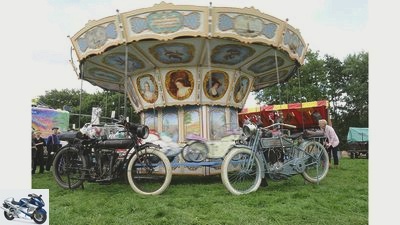
Fred Siemer
10/25
At the exuberantly nostalgic Flaeijelfeest in Nieuwehorne, Frisia, even 100-year-old V-Twins fit perfectly into the picture.
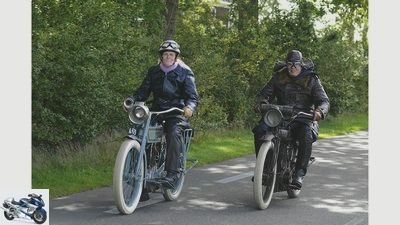
Fred Siemer
11/25
Harley-Davidson Model 11F and Indian Twin Model F.
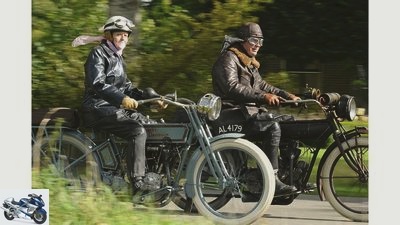
Fred Siemer
12/25
Harley-Davidson Model 11F and Indian Twin Model F.
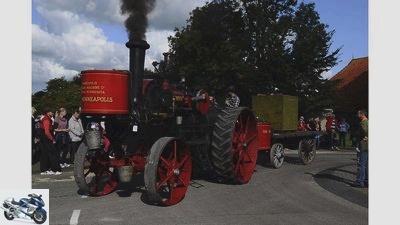
Fred Siemer
13/25
Dat is a steam engine. And many more are coming soon.
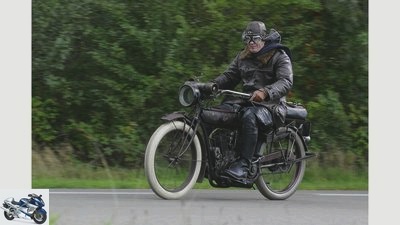
Fred Siemer
14/25
Indian Twin Model F..
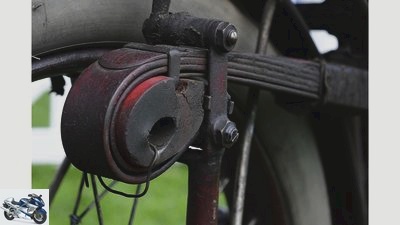
Fred Siemer
15/25
The rear suspension works great, thinks owner Gert Holmersma, Harley, on the other hand, countered it with rather bad gossip.
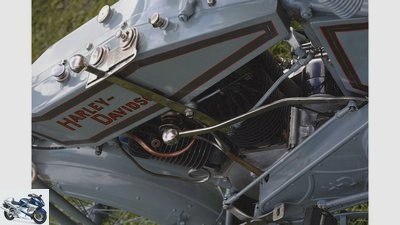
Fred Siemer
16/25
…It used to be heard by Charles Edmond “Titch” Allen, who founded the British Vintage Motorcycle Club VMCC in 1946.
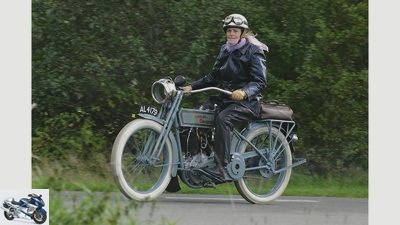
Fred Siemer
17/25
The three-speed transmission was new territory for the company.
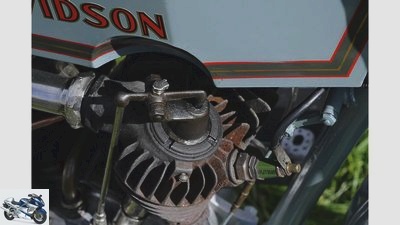
Fred Siemer
18/25
Harley-Davidson Model 11F.
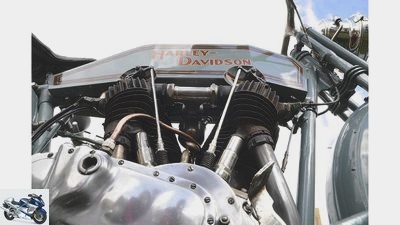
Fred Siemer
19/25
The fork was considered exemplary.
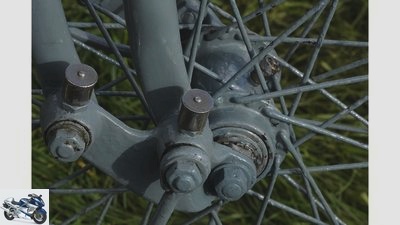
Fred Siemer
20/25
Well cared for, it still impresses today with its great comfort.
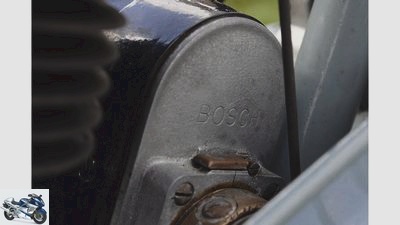
Fred Siemer
21/25
Notable: the sight glass in the engine cover and the magnet “Made in Germany”
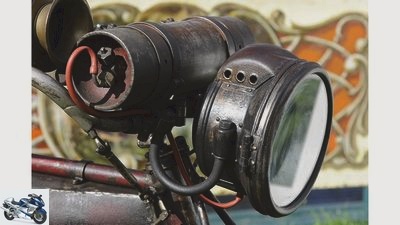
Fred Siemer
22/25
Indian Twin Model F: The gas lamp is supplied with acetylene from the Perst-O-Lite exchange bottle.
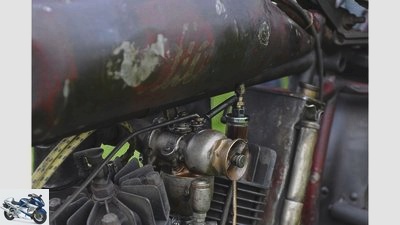
Fred Siemer
23/25
The Schebler carburettor was often retrofitted, tuning in 1914.
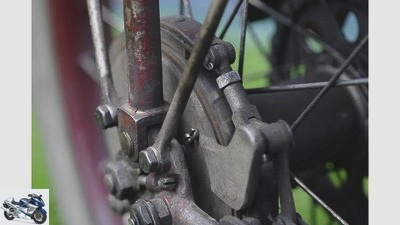
Fred Siemer
24/25
The rear drum brake has an additional outer brake band, and Indian was also in front at the kicker, which Harley only brought much later.
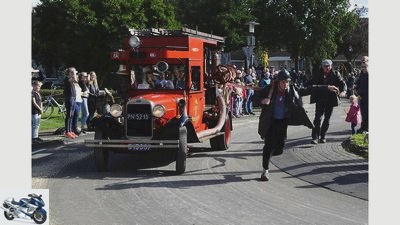
Fred Siemer
25/25
Harley-Davidson Model 11F and Indian Twin Model F.
Harley-Davidson Model 11F and Indian Twin Model F
Close to the beginning
Content of
Two old irons demand justice: The Indian Twin Model F, built in 1914, and the Harley-Davidson Model 11F from 1915 clearly prove that the first chapters of motorcycle history were also written outside of Europe.
When inexperienced onlookers look at vintage cars from the pioneering days, they often enough lapse into mocking cheerfulness. Which of course has to be branded as unhistorical in this magazine, but should at least arouse mild understanding in view of the wobbly front wheel guides, unknown levers and switches or strange wheel sizes. Or is this humorous distance possibly due to the lack of fame, the now unknown name of some motorcycle? A US duo that is over 100 years old, nobody smiles at that. Harley-Davidson Model 11F and I.ndian Twin Model F, the first exquisitely restored, the second in its striking original condition, arouse deep interest and respectful astonishment when they are pushed among the people by their owner. Admittedly, Gert Holmersma uses a large nostalgic festival near his Frisian homeland to demonstrate the two V-Twins: surrounded by ancient tractors, bicycles, horse-drawn carriages and even steam engines, they don’t really look out of place.
Buy complete article
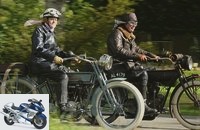
Harley-Davidson Model 11F and Indian Twin Model F
Close to the beginning
Will drive for the next 100 years
Just imagine: this part was built shortly before the outbreak of the First World War. It rushed through lands that only remotely resemble ours. And still drives, unmoved by the times, pretending that nothing will change in the next 100 years. If that doesn’t call for respect.
This Indian Twin Model F had every reason to make a confident appearance in the year it was born, because with almost 32,000 units, its manufacturer, the Hendee Manufacturing Company from Springfield / Massachusetts, was the largest motorcycle manufacturer in the world. Even back then, the V-twin cylinders introduced in 1907 accounted for around 90 percent of production and generated substantial profits. Developed by company co-owner Oscar Hedstrom, the Twins had the brand-typical 42-degree cylinder angle from the start; they were initially created with 640 cc for the traveling people and with 988 for the sportsman, but soon everyone got the whole liter. Since 1908, they have had two alternately controlled valves (inlet via outlet), a central camshaft for actuation and, thanks to clever rocker and angle levers, only one cam each for inlet and outlet is sufficient. Most twins trusted the simple magneto ignition, the carburetor actually came from Indian itself (Hedstrom carburetor), but – as with Gert’s Indian Twin Model F – was gladly exchanged for the mild performance-enhancing counterpart specially offered by the US company Schebler.
Seven horsepower qualified the Indian Twin Model F as a great long-distance motorcycle, which is precisely why it left the much weaker single-cylinder, which had been built since 1901, far behind in the bestseller list. The introduction of the clutch and two-speed gearbox from 1910 onwards increased their capabilities in this regard, and was also considered an expression of a fresh, modern engineering spirit. Groundbreaking, however, were the front short-arm swing arm, which was installed from the same year, and even more the suspension of the rear wheel swing arm, which was optionally available from 1913. Just as a reminder, most Europeans followed suit around 40 years later. A year earlier, running boards and kick starters were included in the range instead of the usual cranks, and in the case of the TT special models they were even part of the standard equipment. The latter in turn crowned the model range because in addition to almost countless successes on the new continent in 1911, there was also a historic triumph at the Senior TT. No less than three Indian racers took first places. To this day, no American motorcycle has ever won again.
Clean throttle response, reliable rev up
While tuned F-engines were sufficient in the Irish Sea, it had to be four-valve engines on the domestic board and speed tracks in order to continue to dominate. Yes, four-valve, as one- and two-cylinder. In front, that was back then where Indian said. The sales and sporting successes were huge, the factory, in which around 3000 people worked, was huge. Called the wigwam, naturally alluding to the brand name and the vermilion paintwork that has been used since 1909. You were the market leader, you wanted to stay that way. Unforgotten the disgrace when many customers suddenly asked for loop frames à la Harley, dismissing the bicycle-inspired Indian tube triangle, which was offered until 1909, as old-fashioned. Later, the small but fine company Reading Standard danced on the noses of the established ones because they generated significantly more power with their pure side valve V2. Charles Gustafson was poached by the competitor, his Powerplus V-Twin made history from 1916 up to the Indian Scout and Chief.
The Model F marks the end of the early years, the Hedstrom era, and that is exactly why Gert Holmersma loves it so much. With all the scratches and cracks in the paint, the faded lettering on the tank, the grease residues on all the grease nipples. Who knows, maybe they are from the early years too. “No,” laughs Gert, “they are mine.” Underneath all this patina there is an amazingly undemanding mechanical fossil, but it does require a little maintenance. It then rewards it with extremely slow idling and well-developed manners. Clean throttle response, reliable revving, high endurance. The last trip to Germany covered 1000 kilometers from west to east, with stages of up to 160 kilometers. And Gert was happy the whole time, even on the steep climb up to the Augustusburg. Even now he shines when they return from a small drive and he parks the Harley-Davidson Model 11F next to the Indian Twin Model F in the paddock. She was allowed to rest, Thea was more like DKW today. Even so, the Harley has not stood idle and has won a prize in the meantime. Best of show, Gert already knows that. “A Harley is always a favorite,” he grins and shrugs his shoulders.
Harley usually lagged a little behind
She used to be “a poor man’s Indian”, but nobody knows that anymore. With this disrespectful saying 100 years ago, many people who wanted to save a few dollars and instead of the Indian turned to one of the less well-equipped Milwaukee irons had to be dealt with. And they were already expensive enough: When Henry Ford had his Model T built on the assembly line from 1914, he was able to reduce its price to 370 dollars. Suddenly an enormous car boom broke out, as early as 1915 US industry sold 895,000 people and 74,000 trucks. Motorcycle sales stalled, Harley reduced the price of the Twins from $ 285 to $ 265, less was not possible, Indian was still slightly higher. Here as there, the number of units sank, only the need of the military after the USA entered the war prevented the production in Milwaukee from previously 15,000 to 10,000 units and in Springfield to under 20,000. The golden days seemed to be over forever, only as a piece of sports equipment, so many manufacturers believed, the motorcycle would be able to survive in America.
In 1914 Harley founded the company’s own sports department. Any questions? Their work should also spur sales of the Model 11F Twin a year later, and the brand new three-speed gearbox wouldn’t hurt either. In doing so, the company actually wanted to outdo Indian, but in Springfield they also increased from two to three gears in 1915, and so everything stayed the same: Harley usually lagged a little behind. After a rather inglorious start in 1909, the V2 did not really get going until 1911, from the beginning with the front fork with pushed short swing arm, which is already known from the single cylinder. Which, by the way, the famous Brit George Brough considered the best of its time and later simply recreated it for his extremely expensive 100-mile racer. At the back, on the other hand, Harley-Davidson remained immobile, and that according to the program: They thought nothing at all about spring-loaded rear swing arms, even with a snappy sideways glance at Indian, assumed that this nonsense was responsible for a lot of chain breaks. The competition was also ahead of the curve when it came to clutches and two-speed transmissions; it wasn’t until 1914 that a half-hub brake drum was available at the rear that was in keeping with the times and performance, as well as optional electric lights and battery ignition.
Downhill with 100 things – no problem
But not with Gert. His Harley-Davidson Model 11F carries – like his Indian – an acetylene gas lamp. However, he did not install the pressure tank for the gas on the Harley. These systems represent a further development of the carbide lamps that have been in use since the turn of the century, in which the acetylene was created on site, because water dripped onto carbide into a container below and reacted to acetylene. Such lamps were more common in Europe than in the USA, because there – see Indian and Harley – the refillable gas cartridges from Perst-O-Lite had already established themselves. And around 1915 they were still considered the more reliable choice when compared to electric light due to the still shaky battery technology.
Back to sacred mechanics. In the Model 11, Harley installed a mechanically driven oil pump for the first time. It uses the smaller, 2.8 liter reservoir of the two-part tank. Gert only uses a hand oil pump that virtually pierces through it when the load is heavy and before long slopes. Which, by the way, require some courage. “Straight down with 100 things – no problem at all. But you know that you will have to brake at some point, ”laughs the happy giant. Only in the back because, as with the Indian, there is nothing in front to brake. After all, the latter has a hand lever that operates an external band brake in addition to the foot-operated jaw – an ineffective concession to British approval regulations, which required two independent stoppers. And an expression of the fact that Indian was also a step ahead in developing lucrative export markets.
European companies in the fast lane
According to American standards, Harley-Davidson relied on vertical exhaust and hanging intake valves, here too, horizontally ribbed cylinder and vertically ribbed cylinder head form a unit. Two noticeable bulges in the tank make space for the bumpers, rocker arms and shafts of the intake valves, so a low permanent oil loss is planned, as with the Indian Twin Model F. All the more sensible that both have an oil sight glass, you can hardly believe it. And another foretaste of the modern can be found on the Harley-Davidson Model 11F: From 1915 onwards, a foot-operated bypass flap was installed, with which you can switch the exhaust from performance-enhancing-loud to environmentally-friendly-quiet. A real gentleman and animal lover would kill it when wagons came towards him, and that’s why it was called a horse hatch. When the pipe is free, the now standard 1000 cm³ (initially 800 cm³) Twin is supposed to produce eleven SAE-PS according to the factory specifications, according to local measurements probably a good eight. Gert Holmersma doesn’t care. After all, he can confirm that the Harley is not a bit slower than the Indian, and this tie has historical significance: Milwaukee had blossomed from a backyard business that could hardly be taken seriously into by far the largest competitor and, thanks to stringent product development, had an excellent reputation with customers.
Unfortunately, the beginning motorcycle crisis prevented a technological arms race. Harley held onto the antiquated F-cylinder head until 1929. In the mid-20s, both companys only sold their Big Twins in homeopathic cans. When they smelled some morning air again after the Great Depression, the big European companies already greeted them from the fast lane. But Thea Bron and Gert Holmersma are only interested in them when they are driving.
Tips for oldie fans
Fred Siemer
Dat is a steam engine. And many more are coming soon.
If you want to see even more wonderful pre-war veterans, we warmly recommend the Ibbenburen motorcycle veterans rally. Every year at Whitsun, this time from May 13th to 16th, around 400 motorcycles and their drivers meet at the largest event of this kind on the continent. Ibbenburen is located west of Osnabruck on the foothills of the Teutoburg Forest, and entry to the well-signposted paddock is of course free.
Further information at www.veteranenrallye.de
And if you want to give yourself the full nostalgia boom, you can go to the Flaeijelfeest in Nieuwehorne near Heerenveen in the Dutch province of Friesland on the last weekend in September. But be careful: In view of the wonderful steam engines, loads of old tractors, cars, motorcycles, a historic fair (with a steep wall with Indian equipment), craft and agricultural demonstrations plus an exuberant good mood, one can easily lose one’s senses at this first-class festival.
More information at www.flaeijel.frl
Technical data Indian Twin Model F
Fred Siemer
100 years ago Indian from Springfield / USA was considered the world’s largest motorcycle manufacturer.
Technical data Indian Twin Model F, built in 1914
engine: Air-cooled 42-degree V-two-cylinder four-stroke engine, two valves each (inlet via outlet), bore 82.5 mm, stroke 93 mm, 994 cm³, rated power 7 HP, a Schebler carburettor, foot-operated multi-plate dry clutch, manual two-speed gearbox , Chain drive
landing gear: Single-loop tubular steel frame, Indian fork at the front with drawn short swing arm and leaf spring, at the rear two-arm tubular swing arm with vertical bracket and two leaf springs, simplex drum brake at the rear with additional, manually operated outer band brake, front and rear tires 28 x 3.00
Weight: about 145 kg
Technical data Harley-Davidson Model 11F
Fred Siemer
This Harley used to belong to Charles Edmond “Titch” Allen, who founded the British Vintage Motorcycle Club VMCC in 1946.
Data Harley-Davidson Model 11F, built in 1915
engine: Air-cooled 45-degree V-two-cylinder four-stroke engine, two valves each (inlet via outlet), bore 84.1 mm, stroke 88.9 mm, 988 cm³, rated output 11 SAE-PS at 3000 / min, a Schebler carburetor , foot or hand-operated multi-plate dry clutch, manual three-speed gearbox, chain drive
landing gear: Single-loop tubular steel frame, Harley oval tube fork at the front with pushed short swing arm and two encapsulated coil springs, at the rear rigid frame, simplex drum brake at the rear, tires at the front and rear 28 x 3.00
Weight: about 150 kg
Related articles
-
Impression – Moto Guzzi California Touring, Indian Springfield and Harley-Davidson Road King Classic
bilski-fotografie.de Impression – Moto Guzzi California Touring, Indian Springfield and Harley-Davidson Road King Classic Westwards Two days free: …
-
Cruiser comparison test Harley-Davidson Forty-Eight, Indian Scout, Victory Gunner
Gargolov 24 pictures RG 1/24 RG 2/24 RG 3/24 RG 4/24 RG 5/24 RG 6/24 RG 7/24 RG 8/24 RG 9/24 RG 10/24 RG 11/24 RG 12 / 24 RG 13/24 RG 14/24 RG 15/24 RG 16/24 …
-
Harley-Davidson Heritage Softail Classic and Indian Chief Vintage put to the test
Gargolov 42 photos Gargolov 1/42 Gargolov 2/42 Its two tension struts work hidden under the gearbox, giving the Softail its rigid frame look. So the…
-
Harley-Davidson Electra Glide Ultra Limited and Indian Roadmaster in comparison
Gargolov 28 photos Gargolov 1/28 Harley-Davidson E-Glide Ultra Limited and Indian Roadmaster. Gargolov 2/28 … Electrically adjustable windshield, four…
-
Africa Twin model presentation
Honda model presentation Africa Twin Is that one … … or that one? Given the very different appearances of the new Honda Africa Twin, a good …
-
Indian Roadmaster special model Jack Daniel’s Limited Edition
Indian 14 images Indian 1/14 Indian is releasing the Jack Daniel’s Limited Edition from the Roadmaster Black Horse. Indian 2/14 Only 107 copies will be …
-
Harley-Davidson Sportster 1200 Custom, Indian Scout Sixty, Yamaha XVS 1300 A Midnight Star
www.bilski-fotografie.de 30 pictures www.bilski-fotografie.de 1/30 Harley-Davidson Sportster 1200 Custom, Indian Scout Sixty and Yamaha XVS 1300 A Midnight …
-
Harley-Davidson model year prices 2019
New Items 2019 Top Subject Harley-Davidson 43 images Harley-Davidson 1/43 Harley-Davidson adds the FXDR 114 to the Softail family for 2019 …
-
Harley-Davidson Fat Bob put to the test
Harley-Davidson Fat Bob put to the test The dynamic promise Harley says the performance of the new Fat Bob would take your breath away. The…
-
Harley-Davidson innovations model year 2018
Harley-Davidson 40 pictures Harley-Davidson 1/40 Harley Davidson Softail Fat Boy (FLFB). Harley-Davidson 2/40 Harley Davidson Softail Fat Boy (FLFB) ….